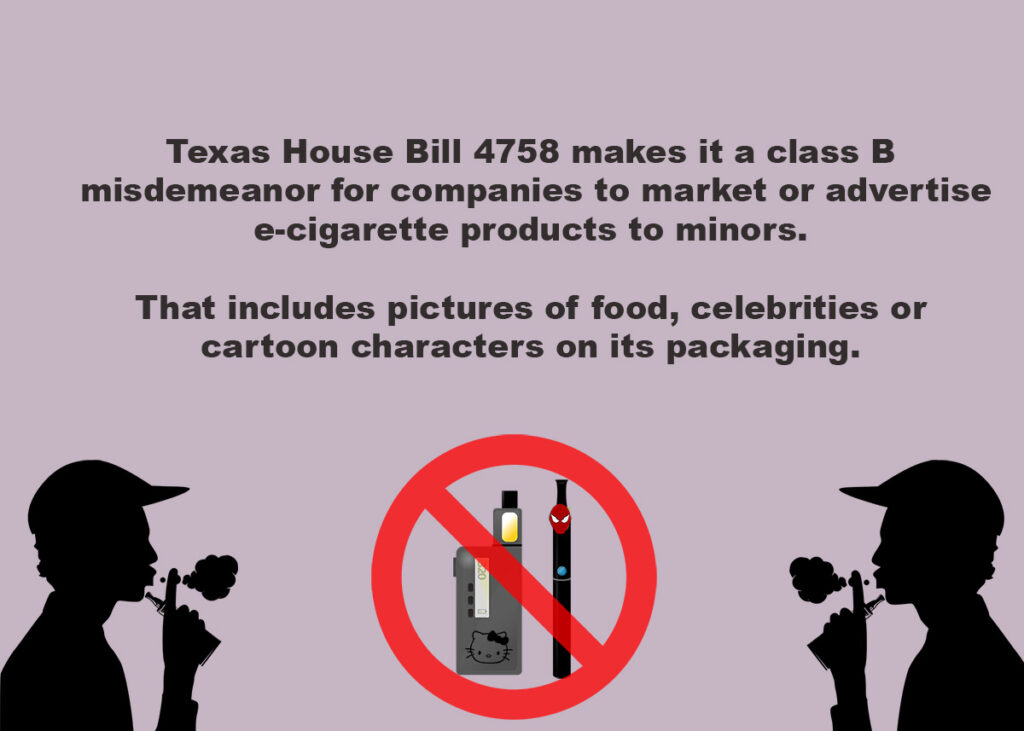Texas law cracks down on marketing toward minors

Texas House Bill 4758 recently went into effect, aiming to curb the appeal of e-cigarettes to minors by restricting packaging and marketing strategies.
“It is illegal to sell e-cigarettes to minors–these products are dangerous and most contain nicotine–heavy metals and cancer-causing materials, yet these products are intentionally designed to attract minors,” Texas Comptroller Glenn Hegar stated in a news release issued in December.
The legislation, titled “Protecting Children from Electronic Cigarette Advertising Act” (HB 4758), took effect Jan. 1 and prohibits the sale of e-cigarette containers utilizing specific design elements that:
–depict a cartoon-like fictional character that mimics a character primarily aimed at entertaining minors
–imitate or mimics trademarks or trade dress of products that are or have been primarily marketed to minors
–include a symbol that is primarily used to market products to minors
–include an image of a celebrity; or
–include an image that resembles a food product, including candy or juice.
“A violation can result in a Class B misdemeanor conviction punishable by up to 180 days in jail, a fine up to $2,000, or both,” according to the news release. “E-cigarette retailers also can face civil penalties up to $3,000 and a permit suspension or revocation for repeat violations.”
The legislation comes amid growing concerns about the rising popularity of e-cigarettes among teenagers, according to the news release.
Sunaina Chugani, an assistant professor of marketing at UTRGV, specializes in consumer behavior and in an interview with The Rider said HB 4758 is a good step to protect children, even if it will not eliminate vaping entirely.
“People who want to vape are still going to vape,” Chugani said.
She said that regulations might make it harder to target certain demographics, but “[e-cigarette companies] will adapt. They will figure out how to stay in business.”
It is also the caregivers’ responsibility to shield minors, according to the assistant professor.
“I have no idea if it’s gonna solve the problem of kids smoking,” she said. “But it’s one step in the right direction.”
Chugani said that product packaging significantly influences how consumers perceive a product.
“If you’re putting colorful characters … things that minors like, on e-cigarettes, it’s absolutely going to increase the appeal of those products,” she said. “They think, ‘Oh, this is something that is meant for me. I want to try it out.’”
Robert Gilbert, an associate professor in graphic design at UTRGV, agrees that using cartoons, candy images and other “positive stimulators” in vape ads are effective because they “sink into the unconscious.”
“It sounds like what they’re trying to do is link those images and those experiences, like eating candy or watching cartoons with vaping,” Gilbert said. “And all of those things are comfort activities, or comfort foods.”
The Rider asked Gilbert how packaging could be designed to effectively communicate that a product is intended for adults only.
“That’s a tricky one,” he said.
Serious or somber tones might work to design advertisements to adults, but that would not communicate the “fun” or “party” aspect some adult vape marketing aims for, Gilbert said.
“But I would say, perhaps, something a little more structured with the typography … less childlike or juvenile colors,” he said. “… And, of course, the image can convey that it’s for an adult audience.”
E-cigarette packaging design can downplay the health risks. Beyond warning, companies will use designers to make the packaging attractive, according to Gilbert.
“That warning has gotta be predominate,” he said. “Maybe there could be a shortened version of the warning on the front, and the extended version on the back.”
Patrick Martinez, a finance junior, said packaging may play a role but is unlikely to be the main reason why minors start vaping.
“They … probably got into it because it was a fad,” Martinez said. “Or because someone they know who does it … peer pressured them, or they were curious and just wanted to try it themselves.”
Celebrity endorsements can also be very influential when marketing to minors, according to Chugani.
Mike Tyson, the American former world heavyweight boxing champion, launched his own product, Vape Tyson, in various fruit flavors.
The Rider asked Chugani how influential this product might be to young consumers.
“Do minors care about Mike Tyson?” she asked. “I don’t know if Mike Tyson is relevant at all, but … if there’s a celebrity that kids look up to … absolutely, it’s going to influence minors.”
Chugani said banning attractive vape designs does not restrict adult consumers’ rights, but it might limit vape companies’ marketing freedom.
“I believe that it’s necessary for us in this free-market economy to have certain regulations that protect vulnerable people,” she said. “So, I think that those [regulations] of the e-cigarettes and vaping companies is one that I think is a reasonable cost, because they do have a product that has the potential for harm.”
Gilbert said he believes e-cigarette companies used childhood nostalgia in their design to purposely target a vulnerable demographic.
“An adult wouldn’t necessarily be attracted to [that design], especially if they’re thinking about smoking,” he said.
Adults would not be drawn to these elements because adult smoking is associated with rebellion and risk-taking, not childish things, according to Gilbert.
“I don’t think an adult, if they’re thinking about smoking, will gravitate to those fruity, you know, happy candylike images,” he said. “The art directors, I think, knew what they were doing.”






